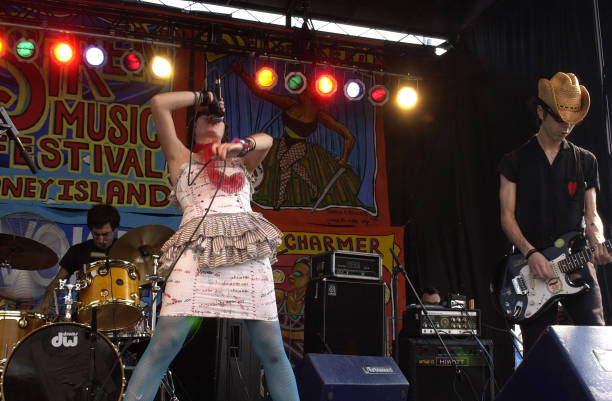“Date with the Night,” the lead single from Yeah Yeah Yeahs’ 2003 debut LP Fever to Tell, heralded the mainstream arrival of a band fervently boosted by critics and industry leaders since the dawn of the millennium. While another song from the same album — the world-conquering “Maps” — turned Yeah Yeah Yeahs into icons, “Date with the Night” is notable for its evocation of New York as a grimy Petri dish of raw creative expression: Nick Zinner’s incinerating guitar and Karen O’s id-borne yelps capture the city in all its storied dirt and danger.
Karen O (née Karen Lee Orzolek) arrived in NYC after transferring to New York University from Ohio’s Oberlin College, where she’d studied film and learned some basic guitar chords. Zinner, meanwhile, studied at Hudson’s Bard College before playing Brooklyn warehouse parties in a band called Challenge of the Future. From there, the story of Yeah Yeah Yeahs progresses like the stories of many classic New York bands: within the confines of the city’s nightspots. There’s Manhattan’s Bar 13, where Karen O frequently attended Shout!, a weekly dance party that anticipated New York’s early-00s rock scene. There’s the endearingly nasty Mars Bar, where she first crossed paths with Zinner. There’s the legendary Sidewalk Cafe, where she and Zinner played gentle folk music together as Unitard before switching to a rougher rock mode. And there’s the Mercury Lounge, where Yeah Yeah Yeahs landed their first show as a rock act — opening a four-band bill headlined by a young Detroit twosome called the White Stripes.
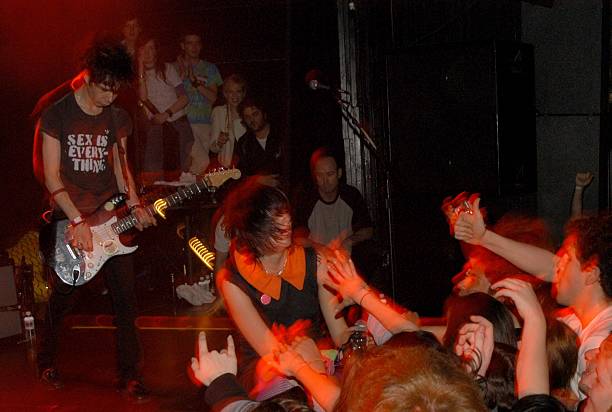
When Yeah Yeah Yeahs’ original drummer couldn’t make the Mercury Lounge show, Karen O recruited Brian Chase, a drummer friend from Oberlin, and he learned the setlist in a week. Channeling disparate influences ranging from the wild sexuality of Stewart Lupton (frontman of NYC’s unsung scene progenitor, Jonathan Fire*Eater) to the brutal energy of the punk bands whose performances she witnessed at Oberlin, Karen O leaned into a chaos that transcended gender boundaries and immediately demonstrated her potential as a show-stopping performer. She swallowed her microphone, dived into the crowd, and grabbed beers tossed onstage, chugging them whole. Her unpredictable movements, as well as her novel status in a genre still dominated by men, quickly made her a star and helped propel the band to near-immediate notoriety.
Shortly after that first Yeah Yeah Yeahs show, another New York band, the Strokes, set fire to the UK with The Modern Age EP, followed by their debut record, Is This It. The Strokes’ sleek, tight, fashionable counter to late-90s post-grunge subsequently earned stateside success as well, almost single-handedly drawing a new focus on New York as a breeding ground for bold rock acts. Yeah Yeah Yeahs (along with bands like post-punk revivalists Interpol and dance-punks the Rapture) benefited immensely from this attention, which was compounded by the band’s inherent charisma: by the time of Yeah Yeah Yeahs’ first tour in the spring of 2002, they had released a shoddily-produced self-titled EP and played a barn-burning set at VICE magazine’s Williamsburg headquarters, and the hype had reached a fever pitch. On the back of that hype, the trio set about recording its debut LP, with friend and mentor Dave Sitek (of future Brooklyn buzz band TV on the Radio) at the helm. The urgency to complete Fever to Tell compelled them to cancel a high-profile tour (including a spot at the 2003 Reading Festival), but the sessions ultimately resulted in an indelible document of Yeah Yeah Yeahs as a fierce, rollicking representative of an exploding scene.
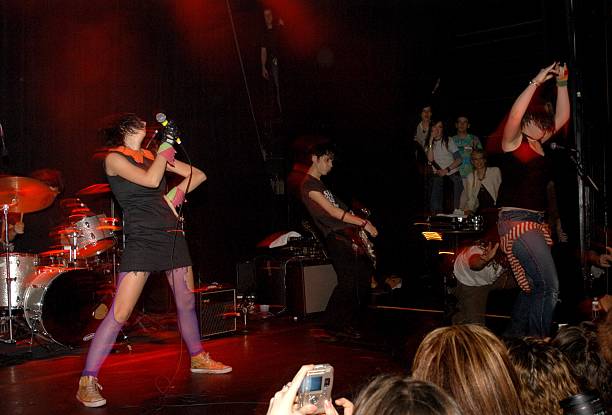
Yeah Yeah Yeahs originally planned to release Fever to Tell on Chicago indie label Touch and Go, but a far more lucrative offer from Universal-owned Interscope, along with guidance from Sonic Youth’s Lee Ranaldo, inspired them to sign with the major label instead. Passing over “Maps” as a single (it dropped in September of that year), the band and label instead decided to declare Yeah Yeah Yeahs’ arrival via “Date with the Night,” released as a single through UK imprint Polydor on April 14, 2003.
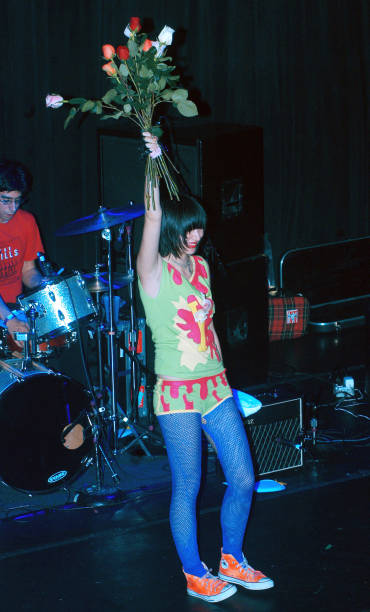
As a time capsule of a fledgling act, Fever to Tell boasts two distinct energies. Most of Side A typifies Yeah Yeah Yeahs’ rowdiness, expressed on blazing tracks like “Man,” “Black Tongue” and “Tick,” while Side B, with latent singles “Maps” and “Y Control,” features their more ambitious compositions. “Date with the Night,” the album’s second track, inarguably leans into revelry: the song is essentially made up of a blues progression around a minor E chord, all played over straight time, but Yeah Yeah Yeahs’ conjure intensity around its simple structure. Chase — the entire rhythm section — provides the backbone via sixteenth hits played between his oscillating hi-hat and his snare, covering the band in flashes of brass. Zinner switches between outlining his minor E on the lowest string and strumming the power chords that make up the rest of the progression, his guitar a downed power line flailing in the air. Karen O’s voice, meanwhile, duels Zinner’s guitar, slithering and bending around her lyrics like a python. Her lyrics sculpt an impressionistic scene of a raucous party — the dancefloor crowded and drenched in sweat, the air heavy with pheromones — and physicality drips off every word; couplets like “Flyin’ out of sight/Droppin’ brides at the altar” channel the noxiousness of a lothario prowling the club, leaving a trail of devastation in his wake.
Then the art-damaged hook appears out of nowhere, right as Yeah Yeah Yeahs are meant to return to the first chord. Karen O’s lyrics set the scene (“Both thighs squeeze tight”) before she gutturally chants the word “choke” over and over, a woman possessed, the microphone seemingly pressed right up to her throat. Chase gives up his quick-footed hi-hat hits and slams on the crash cymbals, one for each beat. Zinner phallically glides over the neck of his guitar in sync with Chase’s crashes, each stroke down the fretboard a punch to the gut. The sudden turnabout summons an indistinct mixture of carnality and violence: the latter in its brutal force, the former in the way it breaks “Date with the Night” out of the confines of its structure, resetting the measure count and rejecting any degree of tonality. It’s up to interpretation who’s actually doing the “choking,” but too much thought spoils the fun; one gets the sense Yeah Yeah Yeahs are simply reveling in the ripples, a momentary lapse into chaos before returning to order.
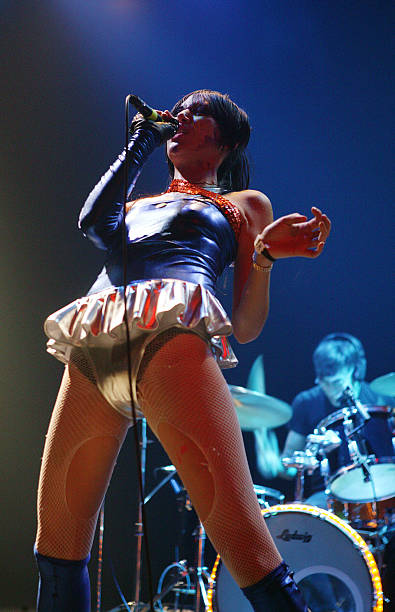
Sitek, who would become a consistent presence behind the boards on Yeah Yeah Yeahs’ future projects, proves his innate adeptness at capturing their power on record. Without bass guitar to provide a tonal low-end, he and 90s alternative powerhouse Alan Moulder fill in the space with the lowest frequencies of Zinner’s distorted guitar and beef up Chase’s kicks and toms. But treble wins out, in the metallic serration of that guitar and in the hollow cavern of the snare hits. Panning Zinner to the left also allows Karen’s voice, amplified and slapbacked, enough space in the mix; a light coating of distortion gives the sultry breaths she tacks on her phrases as much weight as her words.
Though Sitek captures Yeah Yeah Yeahs to tape to the best of anyone’s ability, a song like “Date with the Night” truly thrives on stage. The Fever to Tell version might aim to sound like dynamite in a plastic pool, but so much of the appeal of Yeah Yeah Yeahs comes from the spontaneity of its live performances. Watch footage of the band tackling the song at San Francisco’s Fillmore in 2004 and its potency becomes much clearer; witness the crowd bouncing in unison as Karen O thrashes around in a Christian Joy original dress.
Older, more experienced performers might hold something back on stage for self-preservation. With a head full of steam and a belly full of drinks, Karen O had no such forethought for her well-being. Up until 2006, when she fell off a stage in Australia and suffered a serious head injury, she performed with the kind of recklessness that historically makes for incendiary punk music. Soon after that incident in Australia, that recklessness calloused over into a more pragmatic version of her live persona, one evincing the professional mindset of a next-wave New York band like Vampire Weekend.
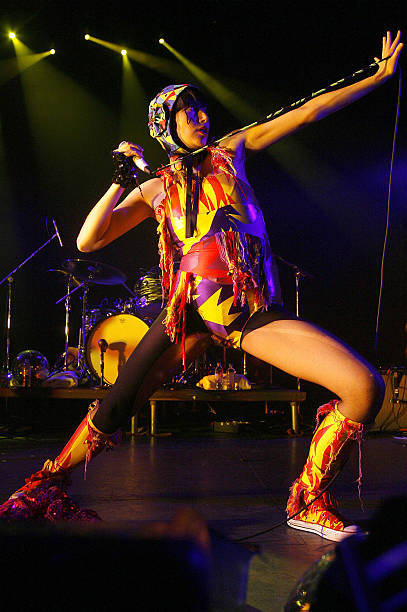
Assisting the transition into that pragmatism, of course, was the eventual triumph of “Maps,” the third single off of Fever to Tell after “Pin” dropped in July 2003. A love song dedicated to Angus Andrew, of fellow New York art-punks Liars, the track rose to prominence when its accompanying music video entered heavy MTV rotation. “Maps” helped triple Fever to Tell’s sales, and it finally climbed into the Billboard Hot 100; the single’s surprise success also set the stage for a more mature version of Yeah Yeah Yeahs, a version whose albums still chart today.
Yet just as Yeah Yeah Yeahs’ irrepressibly wild side has been tempered by age, so too is the New York that backgrounds “Date with the Night.” That version of the city no longer exists; too much corporate-sponsored ambition sanded down its sharp angles, and its underground epiphanies are now muffled by the chirruping blare of mobile device notifications and the thrum of upper-class families pushing strollers.
“Date with the Night” chronicles a moment in history when night in the city still held possibility, back when no alternative to social interaction existed other than meeting in a run-down bar or hitting the dancefloor — where your anxieties and insecurities dissolved in alcohol and sweat, and where you found others to assist you in finding yourself. “There hasn’t been a moment like that since,” concluded Karen O. “And there might not be for a long time.”
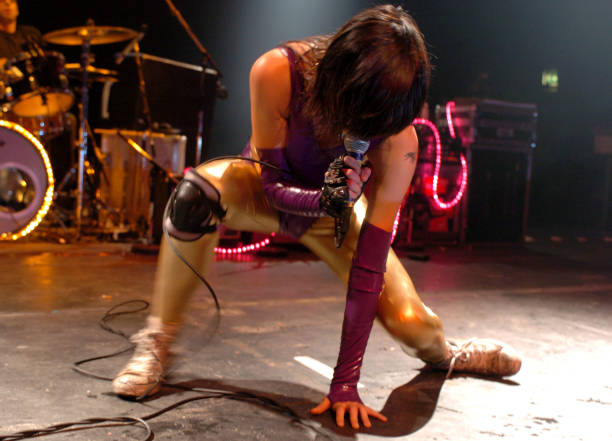
Date with the Night (KORD-0022)

